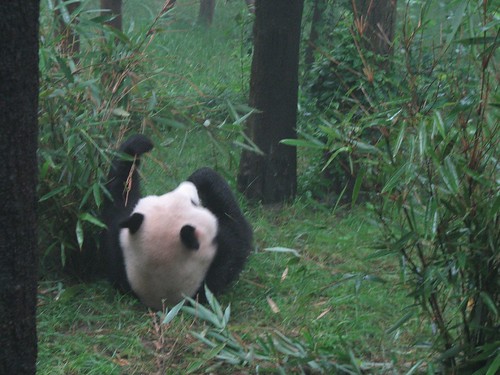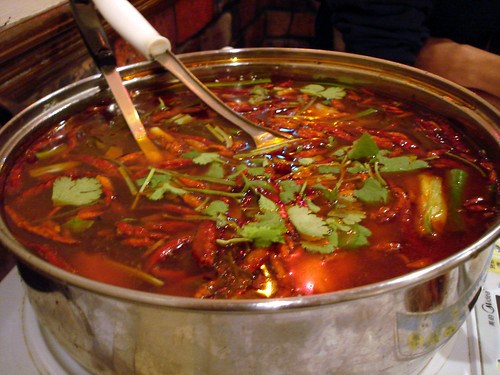
I had the chance recently to go to visit Chengdu, which is located in Sichuan province. Few Americans have likely heard of Chengdu, but it is a major metropolis in China. It was the first imperial capital of China, and remains a cultural, political, economic and most importantly culinary center. It’s other claim to fame is that it is home to the Chinese Panda Research Base, since it is in the heart of the panda’s shrinking geographic range. My trip to the area was short (less than 30 hours), but fun. The first thing I noticed was that it there are no Caucasian people. Well, that’s an overstatement. I saw one German father with his half-chinese kids in the hotel, but that’s it. Chengdu isn’t on most tour group itineraries, and the backpackers in Chengdu heading towards Tibet aren’t hanging out on the street in large enough crowds to be noticed.
If you want to see pandas, there are two places to go.
- Chengdu Panda Research Base: This is just on the outskirts of the city. It’ll take about 20-40 minutes to get there depending on where in the city you are and the traffic. They house about 30 pandas here for breeding and research (but mostly breeding.)
- Wolong Panda Reserve: About 3 hours away from Chengdu, this is more of a conservational effort, housing 150 pandas. They keep the pandas in a more natural environment while studying the animals.
Even though I had arrived in the middle of the night (2 AM) in Chengdu, I got up the next morning at 7 AM to visit the Panda Research Base. Pandas pretty much just eat and sleep, so you have to get to the research center before 10 AM while the animals are still eating. Otherwise, you’ll be lucky to see a panda just sleeping. If you’re unlucky, you’ll see bamboo, behind which a panda is sleeping. I arrived with my coworker at 8 AM, so it was pretty cool. Not the most impressive facility in the world, but amazing to see so many pandas just a few feet away. In most zoos, the two pandas on display are behind high fences and are the prized possession. Here, there are pandas everywhere you turn. On certain days, you can actually pay 400 RMB to get your picture taken petting a panda. Unfortunately, I did not go on such a day.

The other good thing about Chengdu is the food. In the United States, Sichuan food is spicy. If you’ve gone to a Chinese restaurant that has a menu with peppers next to the menu item indicating its spiciness, it’s probably a Sichuan restaurant. But the problem is that until recently, the key ingredient in the food, the Sichuan peppercorn, was banned in the US due to potential bacterial contamination that would harm citrus crops. It has since been lifted as long as the peppercorns are heated to a temperature that can kill the bacteria. Now, most people know I can’t eat a lot of hot foods, but I’ve come to really enjoy Sichuan food. The use of regular chili peppers and Sichuan peppercorns creates a flavor/sensation the Chinese call “mala” or numb and spicy. The peppers add the heat, but a chemical in the peppercorns numb your tongue, removing the heat and pain but allowing you to still taste everything. It’s great. I’m going to bring a kilo of the stuff back with me to the US so I can learn to cook it myself. Fortunately, Sichuan food is popular all across China as well, so if you’re in Beijing, Shanghai, or even Chicago, you can probably find a place that will deliver a decent experience.



1 comment:
where is my panda souvenir?
Post a Comment